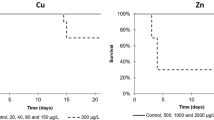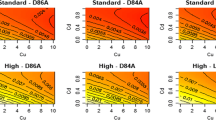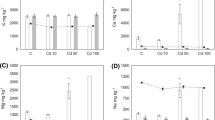Abstract
As one of the most important contaminants, heavy metals can seriously influence human health via the food chain. In this study, the eco-toxicological effects of Cd2+, Pb2+, and Hg2+ on Moina mongolica Daday were investigated by feeding them Chlorella sp. that contained heavy metals. The relative body lengths of the M. mongolica changed rapidly, peaking at 2 days for Hg2+, 6 days for Cd2+, and 8 days for Pb2+. Moreover, grazing and clearance rates of the experimental group were apparently lower than those of the control group after immersion in heavy metals. Additionally, Cd2+ and Pd2+ in the food significantly influenced the mean lifespan of M. mongolica of the P and F1 generations. Egg production per brood was also significantly impacted by Cd2+ and Pb2+ in the food in generation P. Interestingly, Pb2+ was the only metal that significantly influenced the reproduction times of F2, while the reproductive times were significantly influenced by Cd2+ for generation P. Moreover, Cd2+, Pb2+, and Hg2+ in the food significantly influenced the fecundity of generation P. Evaluation of the population growth parameters of M. mongolica revealed that the intrinsic rate of increase, net reproduction rate, and finite rate of increase were significantly influenced by Cd2+, Pb2+, and Hg2+ in the food in generation P. Additionally, Hg2+ slightly impacted generation time for generation P. Finally, the acute toxicity toward M. mongolica was Hg2+ > Cd2+ > Pb2+. Overall, heavy metals in the food were likely to influence the growth, survival, and population growth of M. mongolica through the food chain.










Similar content being viewed by others
References
Amoozadeh E, Malek M, Rashidinejad R, Nabavi S, Karbassi M, Ghayoumi R, Ghorbanzadeh-Zafarani G, Salehi H, Sures B (2014) Marine organisms as heavy metal bioindicators in the Persian Gulf and the Gulf of Oman. Environ Sci Pollut Res 21:2386–2395
An Y, He Z (1991) Toxicity of four heavy metals in marine water to Moina mongolica. Journal of fisheries of China/Shuichan Xuebao. Shanghai 15:273–282 (in Chinese with English abstract)
Barata C, Markich S, Baird D, Soares A (2002) The relative importance of water and food as cadmium sources to Daphnia magna Straus. Aquat Toxicol 61:143–154
Biesinger K, Christensen G (1972) Effects of various metals on survival, growth, reproduction, and metabolism of Daphnia magna. J Fish Board Canada 29:1691–1700
Catton J, Adema D (1978) Reproducibility of shorterm and reproduction toxieity experiments with Daphnia magna and comparison of the sensitivity of Daphnia magna with Daphnia pulex and Daphnia cucullata in shorter experiments. Hydrobiol 59:135–140
Chen C, Stemberger R, Klaue B, Blum J, Pickhardt P, Folt C (2000) Accumulation of heavy metals in food web components across a gradient of lakes. Limnol Oceanogr 45:1525–1536
Cheng S (2003) Heavy metal pollution in China: origin, pattern and control. Environ Sci Pollut Res 10:192–198
Dumont H, Van de Velde I, Dumont S (1975) The dry weight estimate of biomass in a selection of Cladocera, Copepoda and Rotifera from the plankton, periphyton and benthos of continental waters. Oecologia 19:75–97
Fijałkowski K, Kacprzak M, Grobelak A, Placek A (2012) The influence of selected soil parameters on the mobility of heavy metals in soils. Inż Ochrona Srodowiska 15:81–92
Fowden A, Giussani D, Forhead A (2006) Intrauterine programming of physiological systems: causes and consequences. Physiology 21:29–37
Gaur N, Flora G, Yadav M, Tiwari A (2014) A review with recent advancements on bioremediation-based abolition of heavy metals. Environ Sci: Process Impacts 16:180–193
Grant C, Clarke J, Duguid S, Chaney R (2008) Selection and breeding of plant cultivars to minimize cadmium accumulation. Sci Total Environ 390:301–310
He Z, Qin J, Wang Y, Jiang H, Wen Z (2001) Biology of Moina mongolica (Moinidae, Cladocera) and perspective as live food for marine fish larvae. Hydrobiologia 457:25–37
Jiang J, Li L, Li H, Li F (2012) Biosorption of lead (II) and cadmium (II) from aqueous solution by Chlorella pyrenoidsa and its influential factors. Acta Ecologica Sinica 32:1995–2003
Korashy H, Attafi I, Famulski K, Bakheet S, Hafez M, Alsaad A et al (2017) Gene expression profiling to identify the toxicities and potentially relevant human disease outcomes associated with environmental heavy metal exposure. Environ Pollut 221:64–74
Liu Y, Chen M, Jiang L, Song L (2014) New insight into molecular interaction of heavy metal pollutant—cadmium (II) with human serum albumin. Environ Sci Pollut Res 21:6994–7005
Mangin K, Lipsitch M, Ebert D (1995) Virulence and transmission modes of two microsporidia in Daphnia magna. Parasitology 111:133–142
Massaquoi L, Ma H, Liu X, Han P, Zuo S, Hua Z et al (2015) Heavy metal accumulation in soils, plants, and hair samples: an assessment of heavy metal exposure risks from the consumption of vegetables grown on soils previously irrigated with wastewater. Environ Sci Pollut Res 22:18456–18468
Morales M, Derbes R, Ade C, Ortego J, Stark J, Deininger P et al (2016) Heavy metal exposure influences double strand break DNA repair outcomes. Plos One 11:e0151367
Morgan J, Iwama G (1991) Effects of salinity on growth, metabolism, and on regulation in juvenile rainbow and steel2head trout and fall Chinook salmon. Can J Fish Aquat Sci 8:2083–2094
Mount D, Norberg T (1984) A seven-day life cycle cladoceran toxicity test. Environ Toxicol Chem 3:425–434
Nasri I, Hammouda A, Hamza F, Zrig A, Selmi S (2017) Heavy metal accumulation in lizards living near a phosphate treatment plant: possible transfer of contaminants from aquatic to terrestrial food webs. Environ Sci Pollut Res 24:12009–12014
Pan J, Lin R, Ma L (2000) A review of heavy mental adsorption by marine algae. Chin J Oceanol Limnol 18:260–264
Peralta-Videa J, Lopez M, Narayan M, Saupe G, Gardea T (2009) The biochemistry of environmental heavy metal uptake by plants: implications for the food chain. Int J Biochem Cell Biol 41:1665–1677
Seo J, Lee K, Rhee J, Hwang D, Lee Y, Park H et al (2006) Environmental stressors (salinity, heavy metals, H2O2) modulate expression of glutathione reductase (GR) gene from the intertidal copepod Tigriopus japonicus. Aquat Toxicol 80:281–289
Shi L (2009) Research on the toxicity of heavy metals on Chlorella sp. and the adsorption of Hg2+ by Chlorella sp. Northeastern University press, Shenyang (In Chinese)
Tao Y, Yuan Z, Xiaona H, Wei M (2012) Distribution and bioaccumulation of heavy metals in aquatic organisms of different trophic levels and potential health risk assessment from Taihu lake, China. Ecotoxicol Environ Saf 81:55–64
Verriopoulos G, Dimas S (1988) Combined toxicity of copper, cadmium, zinc, lead, nickel, and chrome to the copepodTisbe holothuriae. Bull Environ Contam Toxicol 41:378–384
Vosylienė M, Mikalajūnė A (2006) Effect of heavy metal model mixture on rainbow trout biological parameters. Ekologija 4:12–17
Wang Z, Kong H, Wu D (2007) Reproductive toxicity of dietary copper to a saltwater cladoceran, Moina monogolica daday. Environ Toxicol Chem 26:126–131
Wang J, Peng S, Chen T, Zhang L (2016a) Occurrence, source identification and ecological risk evaluation of metal elements in surface sediment: toward a comprehensive understanding of heavy metal pollution in Chaohu Lake, Eastern China. Environ Sci Pollut Res 23:307–314
Wang Z, Wang Y, Yan C (2016b) Simulating ocean acidification and CO2 leakages from carbon capture and storage to assess the effects of pH reduction on cladoceran M. mongolica and its progeny. Chemosphere 155:621–629
Wang Z, Yan C, Zhang X (2009) Acute and chronic cadmium toxicity to a saltwater cladoceran Moina monogolica Daday and its relative importance. Ecotoxicology 18:47–54
Yi Y, Yang Z, Zhang S (2011) Ecological risk assessment of heavy metals in sediment and human health risk assessment of heavy metals in fishes in the middle and lower reaches of the Yangtze River basin. Environ Pollut 159:2575–2585
Zhang X, Zhong T, Liu L, Ouyang X (2015) Impact of soil heavy metal pollution on food safety in China. PLoS One 10:e0135182
Zhao W, He Z, Yin S (2008) Biology and technology of culture and utilization in marine water for cladocera in inland saline waters. Science Press, Beijing (In Chinese)
Zhou Y, Zhang Z (1989) Method of toxicity tests for aquatic organism. China Aqriculture Press, Beijing (In Chinese)
Zhuang D (1996) Study of the toxicity of heavy metals to Ceriodaphnia quadrangula. Chongqing Environ Sci 18:47–50 (In Chinese)
Acknowledgments
This study was supported by the National Natural Science Foundation of China (No. 41501535). We thank Liwen Bianji, Edanz Group China (www.liwenbianji.cn/ac), for editing the English text of a draft of this manuscript.
Author information
Authors and Affiliations
Corresponding author
Additional information
Responsible editor: Philippe Garrigues
Rights and permissions
About this article
Cite this article
Wang, M., Zhao, W., Jia, X. et al. Eco-toxicology effect on Moina mongolica Daday exposed to Cd2+, Pb2+, and Hg2+ by the food chain. Environ Sci Pollut Res 25, 16024–16036 (2018). https://doi.org/10.1007/s11356-018-1800-1
Received:
Accepted:
Published:
Issue Date:
DOI: https://doi.org/10.1007/s11356-018-1800-1




